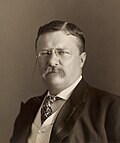List
The following U.S. presidents were Freemasons: [3]
| Name | Presidency | Details | |
|---|---|---|---|
 | George Washington (1732–1799) | 1st • April 30, 1789 – March 4, 1797 | Initiated on November 4, 1752, in Fredericksburgh Lodge No. 4, Fredericksburg, Virginia. Elected Worshipful Master on December 20, 1788 |
 | James Monroe (1758–1831) | 5th • March 4, 1817 – March 4, 1825 | Initiated on November 9, 1775, in Williamsburg Lodge No. 6, Williamsburg, Virginia at the age of 17 while studying at the College of William & Mary [4] |
 | Andrew Jackson (1767–1845) | 7th • March 4, 1829 – March 4, 1837 | Member of St. Tammany (later Harmony) Lodge No. 1, Nashville, Tennessee. Elected Grand Master of Tennessee on October 7, 1822, and served until October 4, 1824 |
 | James K. Polk (1795–1849) | 11th • March 4, 1845 – March 4, 1849 | Initiated on June 5, 1820, in Columbia Lodge No. 31, Columbia, Tennessee |
 | James Buchanan (1791–1868) | 15th • March 4, 1857 – March 4, 1861 | Initiated on December 11, 1816, in Lodge No. 43, Lancaster, Pennsylvania. Appointed District Deputy Grand Master for the counties of Lancaster, Lebanon, and York in 1824 |
 | Andrew Johnson (1808–1875) | 17th • April 15, 1865 – March 4, 1869 | Initiated on May 5, 1851, in Greenville Lodge No. 119, Greeneville, Tennessee |
 | James A. Garfield (1831–1881) | 20th • March 4, 1881 – September 19, 1881 | Initiated on November 19, 1861, in Magnolia Lodge No. 20, Columbus, Ohio and raised on November 22, 1864 in Columbus Lodge No. 30. Joined Garrettsville Lodge No. 246, Garrettsville, Ohio in 1866 and was its chaplain for the years 1868-69. Charter Member of Pentalpha Lodge No. 23, Washington, D.C. |
 | William McKinley (1843–1901) | 25th • March 4, 1897 – September 14, 1901 | Initiated on May 1, 1865, in Hiram Lodge No. 21, Winchester, Virginia. Joined Canton Lodge No. 60, Canton, Ohio in 1867. Charter member of Eagle (later William McKinley) Lodge No. 431, also in Canton |
 | Theodore Roosevelt (1858–1919) | 26th • September 14, 1901 – March 4, 1909 | Initiated on January 2, 1901, in Matinecock Lodge No. 806, Oyster Bay, New York. Raised to Master Mason on April 24, 1901 [5] |
 | William H. Taft (1857–1930) | 27th • March 4, 1909 – March 4, 1913 | Made a Mason at sight on February 18, 1909, in Kilwinning Lodge No. 356, Cincinnati, Ohio [6] |
 | Warren G. Harding (1865–1923) | 29th • March 4, 1921 – August 2, 1923 | Initiated on June 28, 1901, in Marion Lodge No. 70, Marion, Ohio. Raised on August 27, 1920 in that Lodge. [3] 32nd Degree member of Scioto Consistory, Ancient and Accepted Scottish Rite [7] |
 | Franklin D. Roosevelt (1882–1945) | 32nd • March 4, 1933 – April 12, 1945 | Initiated on October 11, 1911, in Holland Lodge No. 8, New York City. Made a Prophet-at-Sight in Tri-Po-Bed Grotto on October 30, 1931. Made Honorary Grand Master of the Order of DeMolay on April 13, 1934 |
 | Harry S. Truman (1884–1972) | 33rd • April 12, 1945 – January 20, 1953 | Initiated on February 9, 1909, in Belton Lodge No. 450, Belton, Missouri. First Worshipful Master of Grandview Lodge No. 618, Grandview, Missouri in 1911. Elected Grand Master of Missouri on September 25, 1940 and served until October 1, 1941. Received the 33rd Degree of the Scottish Rite on October 19, 1945. Made Honorary Grand Master of the Order of DeMolay on May 18, 1959 |
 | Lyndon B. Johnson (1908–1973) | 36th • November 22, 1963 – January 20, 1969 | Initiated as Entered Apprentice on October 30, 1937 in Johnson City Lodge No. 561 at Johnson City, Texas. Did not advance any further and did not become a full member of his lodge. [8] [9] Robert Caro does not mention Johnson's Masonic membership or failure to advance in Book One: The Path to Power of his four-volume biography of Johnson. |
 | Gerald Ford (1913–2006) | 38th • August 9, 1974 – January 20, 1977 | Initiated on September 30, 1949, in Malta Lodge No. 465, Grand Rapids, Michigan. Passed on April 20, 1951 and raised on May 18 of that year in Columbia Lodge No. 3, Washington, D.C. Received the 33rd Degree on September 26, 1962. Made Honorary Grand Master of the Order of DeMolay in April 1975 |
In addition to the individuals listed above, Ronald Reagan was made an honorary Freemason, [10] and as a youth, Bill Clinton was a member of the Masonic youth group Order of DeMolay. [11]








